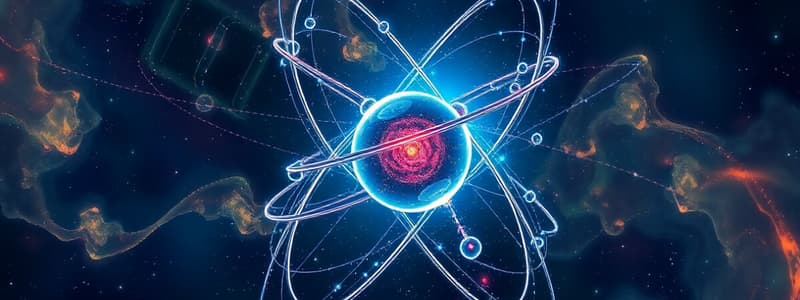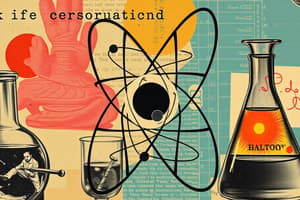Podcast
Questions and Answers
Who is credited with first proposing that matter consists of indivisible particles called 'atomos'?
Who is credited with first proposing that matter consists of indivisible particles called 'atomos'?
- Aristotle
- John Dalton
- Plato
- Democritus (correct)
John Dalton believed that atoms of a specific element can be transformed into atoms of another element during a chemical reaction.
John Dalton believed that atoms of a specific element can be transformed into atoms of another element during a chemical reaction.
False (B)
What instrument did J.J. Thomson use in his experiment that led to the discovery of the electron?
What instrument did J.J. Thomson use in his experiment that led to the discovery of the electron?
cathode ray tube
According to Dalton's atomic theory, compounds are formed when atoms come together in specific ______.
According to Dalton's atomic theory, compounds are formed when atoms come together in specific ______.
Match the scientist with their contribution to the development of atomic theory:
Match the scientist with their contribution to the development of atomic theory:
Which of the following is NOT a key postulate of Dalton's atomic theory?
Which of the following is NOT a key postulate of Dalton's atomic theory?
Discussions about elemental forms of matter only started in the 1800s when John Dalton published his atomic theory.
Discussions about elemental forms of matter only started in the 1800s when John Dalton published his atomic theory.
What caused the rays in Thomson's cathode ray tube experiment to curve?
What caused the rays in Thomson's cathode ray tube experiment to curve?
Which scientist is credited with discovering that an atom has a nucleus?
Which scientist is credited with discovering that an atom has a nucleus?
Niels Bohr discovered the neutron.
Niels Bohr discovered the neutron.
What model of the atom did J.J. Thomson propose?
What model of the atom did J.J. Thomson propose?
Rutherford discovered the proton by bombarding nitrogen nuclei with alpha particles as it ejected a ______ atom.
Rutherford discovered the proton by bombarding nitrogen nuclei with alpha particles as it ejected a ______ atom.
Match the scientist with their contribution to atomic theory:
Match the scientist with their contribution to atomic theory:
What result from Rutherford's gold foil experiment led him to conclude that atoms have a dense, positively charged nucleus?
What result from Rutherford's gold foil experiment led him to conclude that atoms have a dense, positively charged nucleus?
Bohr's model successfully explained the spectral lines of all elements.
Bohr's model successfully explained the spectral lines of all elements.
According to Bohr, what form of energy is absorbed or emitted an electron jumps between energy levels?
According to Bohr, what form of energy is absorbed or emitted an electron jumps between energy levels?
Flashcards
Early atomic theories
Early atomic theories
Philosophers like Plato and Aristotle discussed the nature of matter around 300-600 B.C.
Democritus
Democritus
First proposed that matter is made of indivisible particles called 'atomos'.
Origin of 'atom'
Origin of 'atom'
The term 'atom' comes from the Greek word 'atomos', meaning 'indivisible'.
John Dalton
John Dalton
Signup and view all the flashcards
Dalton's atomic theory postulates
Dalton's atomic theory postulates
Signup and view all the flashcards
J.J. Thomson
J.J. Thomson
Signup and view all the flashcards
Cathode ray tube
Cathode ray tube
Signup and view all the flashcards
Electron discovery
Electron discovery
Signup and view all the flashcards
Charge and mass of electron
Charge and mass of electron
Signup and view all the flashcards
Plum pudding model
Plum pudding model
Signup and view all the flashcards
Rutherford's discovery
Rutherford's discovery
Signup and view all the flashcards
Gold foil experiment
Gold foil experiment
Signup and view all the flashcards
Rutherford's proton discovery
Rutherford's proton discovery
Signup and view all the flashcards
James Chadwick's neutron discovery
James Chadwick's neutron discovery
Signup and view all the flashcards
Bohr model of the atom
Bohr model of the atom
Signup and view all the flashcards
Photon energy transitions
Photon energy transitions
Signup and view all the flashcards
Study Notes
History of Atomic Structure Research
- Early atomic theories were discussed by philosophers like Plato, Aristotle, and Anaximander of Miletus, between 300-600 B.C.
- Democritus proposed that matter is made up of indivisible particles called "atomos."
- John Dalton (1766-1844) developed an atomic theory based on postulates about elements, atoms, and how they react.
Dalton's Atomic Theory
- Elements are made of tiny particles called atoms.
- All atoms of an element are identical in physical and chemical properties.
- Atoms cannot be created, destroyed, or changed into another type of atom.
- A chemical reaction involves rearranging atoms.
- Compounds are formed when certain atoms combine in specific ratios.
Thomson's Contributions
- J.J. Thomson (1856-1940) discovered the electron using cathode ray tubes in a magnetic field.
- He determined the charge-to-mass ratio of the electron, which led to the calculation of its mass.
- His model of the atom is known as the "plum pudding" model, with negatively charged electrons embedded in a positively charged sphere.
Rutherford's Contributions
- Ernest Rutherford (1871-1937) conducted the gold foil experiment, which helped determine the structure of an atom.
- The experiment revealed that atoms have a small, dense, and positively charged nucleus at the center, with electrons orbiting it.
- Rutherford also discovered the proton.
Chadwick's Contributions
- James Chadwick (1891-1974) discovered the neutron as a neutral particle within the atom.
Bohr's Contributions
- Niels Bohr (1885-1962) developed the Bohr model, proposing that electrons orbit the nucleus in specific energy levels.
- Electrons can jump between energy levels by absorbing or emitting energy (photons).
- Bohr's model accurately predicted the spectral lines of hydrogen, providing further understanding of atomic behavior.
Studying That Suits You
Use AI to generate personalized quizzes and flashcards to suit your learning preferences.




